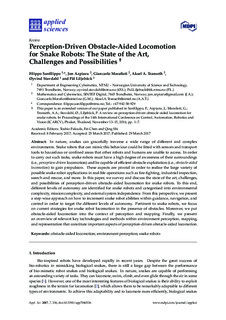| dc.contributor.author | Sanfilippo, Filippo | |
| dc.contributor.author | Azpiazu, Jon | |
| dc.contributor.author | Marafioti, Giancarlo | |
| dc.contributor.author | Transeth, Aksel Andreas | |
| dc.contributor.author | Stavdahl, Øyvind | |
| dc.contributor.author | Liljebäck, Pål | |
| dc.date.accessioned | 2017-10-25T14:26:42Z | |
| dc.date.available | 2017-10-25T14:26:42Z | |
| dc.date.created | 2017-03-30T10:46:06Z | |
| dc.date.issued | 2017 | |
| dc.identifier.citation | Applied Sciences. 2017, 7 (4), . | nb_NO |
| dc.identifier.issn | 2076-3417 | |
| dc.identifier.uri | http://hdl.handle.net/11250/2462207 | |
| dc.description.abstract | In nature, snakes can gracefully traverse a wide range of different and complex environments. Snake robots that can mimic this behaviour could be fitted with sensors and transport tools to hazardous or confined areas that other robots and humans are unable to access. In order to carry out such tasks, snake robots must have a high degree of awareness of their surroundings (i.e., perception-driven locomotion) and be capable of efficient obstacle exploitation (i.e., obstacle-aided locomotion) to gain propulsion. These aspects are pivotal in order to realise the large variety of possible snake robot applications in real-life operations such as fire-fighting, industrial inspection, search-and-rescue, and more. In this paper, we survey and discuss the state of the art, challenges, and possibilities of perception-driven obstacle-aided locomotion for snake robots. To this end, different levels of autonomy are identified for snake robots and categorised into environmental complexity, mission complexity, and external system independence. From this perspective, we present a step-wise approach on how to increment snake robot abilities within guidance, navigation, and control in order to target the different levels of autonomy. Pertinent to snake robots, we focus on current strategies for snake robot locomotion in the presence of obstacles. Moreover, we put obstacle-aided locomotion into the context of perception and mapping. Finally, we present an overview of relevant key technologies and methods within environment perception, mapping, and representation that constitute important aspects of perception-driven obstacle-aided locomotion | nb_NO |
| dc.language.iso | eng | nb_NO |
| dc.publisher | MDPI | nb_NO |
| dc.rights | Navngivelse 4.0 Internasjonal | * |
| dc.rights.uri | http://creativecommons.org/licenses/by/4.0/deed.no | * |
| dc.title | Perception-Driven Obstacle-Aided Locomotion for Snake Robots: The State of the Art, Challenges and Possibilities | nb_NO |
| dc.type | Journal article | nb_NO |
| dc.type | Peer reviewed | nb_NO |
| dc.description.version | publishedVersion | nb_NO |
| dc.source.pagenumber | 22 | nb_NO |
| dc.source.volume | 7 | nb_NO |
| dc.source.journal | Applied Sciences | nb_NO |
| dc.source.issue | 4 | nb_NO |
| dc.identifier.doi | 10.3390/app7040336 | |
| dc.identifier.cristin | 1462306 | |
| dc.relation.project | Norges forskningsråd: 240072 | nb_NO |
| dc.description.localcode | © 2017 The Authors. This is an open access article distributed under the Creative Commons Attribution License which permits unrestricted use, distribution, and reproduction in any medium, provided the original work is properly cited. (CC BY 4.0). | nb_NO |
| cristin.unitcode | 194,63,25,0 | |
| cristin.unitname | Institutt for teknisk kybernetikk | |
| cristin.ispublished | true | |
| cristin.fulltext | original | |
| cristin.qualitycode | 1 | |

